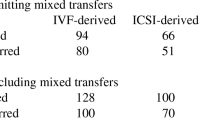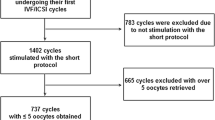Abstract
Objective: Our objective was to investigate whether the quality of embryos developed after intracytoplasmic sperm injection (ICSI) is better than that of conventional IVF embryos.
Methods: Nine couples who previously achieved a normal rate of fertilization following IVF and four couples whose normal rate of fertilization was expected were involved in this study. The oocytes from those couples were randomly divided into two groups, group A by conventional insemination and group B by ICSI. The fertilization rate and quality of embryos were compared.
Results: Normal fertilization was achieved in 61% of the oocytes (83/136) after conventional insemination. In group B, 69% of the oocytes (99/144) achieved normal fertilization, although only 127 metaphase II oocytes were injected using the ICSI technique. More grade A embryos were obtained when the ICSI technique was used for fertilization than by conventional IVF (35.4 and 24.3%, respectively;P=0.028).
Conclusions: A similar fertilization rate can be achieved by ICSI in comparison with conventional IVF, when male factor is not involved. Embryos after ICSI have an improved quality.
Similar content being viewed by others
References
Tsirigotis M, Yang D, Redgment C J, Nicholson N, Pelekanos M, Craft I C: Assisted fertilization with intracytoplasmic sperm injection. Fertil Steril 1994;62:781–785
Van Steirteghem A C, Nagy Z, Joris H, Liu J, Staessen C, Smitz J, Wisanto A, Devroey P: High fertilization and implantation rates after intracytoplasmic sperm injection. Hum Reprod 1993;8:1061–1066
Guerin J F, Mathieu C, Lornage J, Pinatel M C, Boulieu D: Improvement of survival and fertilizing capacity of human spermatozoa in an IVF program by selection on discontinuous Percoll gradients. Hum Reprod 1989;4:798–904
Al-Shawaf T, Yang D, Al-Magid Y, Seaton A, Iketubosin F, Craft I L: Ultrasonic monitoring during replacement of frozen/thawed embryos in natural and hormone replacement cycles. Hum Reprod 1993;8:2068–2074
Cohen J, Feldberg D: Effects of the size and number of zona pellucida openings on hatching and trophoblast outgrowth in the mouse embryo. Mol Reprod Dev 1991;30:70–78
Alvarez J G, Touchstone J C, Blasco L, Storey B T: Spontaneous lipid peroxidation and production of hydrogen peroxide and superoxide in human spermatozoa. Superoxide dismutase as major enzyme protectant against oxygen toxicity. J Androl 1987;8:338–348
Atiken R J, Clarkson J S: Cellular basis of defective sperm function and its association with the genesis of reactive oxygen species by human spermatozoa. J Reprod Fertil 1987;81:459–469
Author information
Authors and Affiliations
Rights and permissions
About this article
Cite this article
Yang, D., Shahata, M.A., Al-Bader, M. et al. Intracytoplasmic sperm injection improving embryo quality: Comparison of the sibling oocytes of Non-Male-Factor couples. J Assist Reprod Genet 13, 351–355 (1996). https://doi.org/10.1007/BF02070151
Received:
Accepted:
Issue Date:
DOI: https://doi.org/10.1007/BF02070151




